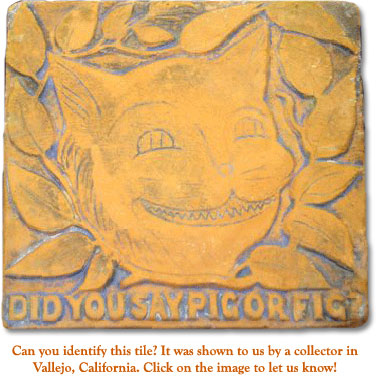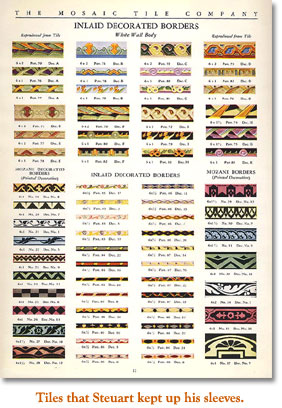

(Available each month to Tile Heritage members who e-mail the Foundation from the address they
would like
E-News sent to. Contact: foundation@tileheritage.org)
PRINTED VERSION
Here’s What’s Below:
Newlyweds in Turkey
Teachers Take Notice
Over 60 ("Healthy") Tiles
True Mosaics Brighten Brentwood
Where were you in '59, Pomona?
Just in from Denver
New Books
Weller Tile's Founder Dies
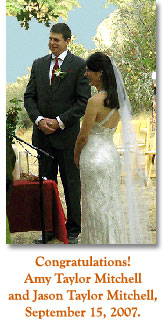
Newlyweds in Turkey
In mid-September a group of us gathered at Emandal, a self-sustaining farm on the Eel River northeast of Willits, California, to celebrate the marriage of Amy Taylor and Jason Mitchell. It was a 3-day affair with both friends and relatives in attendance, about 140 of us in all, from all over the country. For an outdoor wedding the weather couldn't have been more perfect for this time of year. Li Ping Zhu, a close friend of the bride and groom from San Francisco, officiated during the service, which was held in a clearing adjacent to the river; she played a large Chinese harp as a prologue. The groom and bride were ushered in with the stirring skirl of bagpipes played by Mary Taylor. It was quite a lovely occasion!
Amy and Jason, Californians by birth, met at post-graduate school in San Francisco; they are both practicing acupuncturists in Berkeley. When they made the decision to spend their honeymoon in Turkey, we knew they'd return raving about all the tiles they saw! Rest assured we'll be sharing their pictures with you in the months ahead.
Clay in the Classroom resources link is now active! Check out the THF website Home Page for the
Clay in the Classroom active icon.
Tile Heritage has developed a link to resources for teachers who are involved with clay in the classroom
and for those who wish to bring a clay program to their classroom. This includes "kids" of all ages: preschool.
K-12, college and adult education. Two links are complete: THF Direct Resources and Useful Websites.
A third link is "under construction," Individual Teachers with Information to Share. To utilize information
posted on the links go to:
Clay in the Classroom
To contribute information to share with others, please email the resources or information to
foundation@tileheritage.org. Use "Clay in the Classroom"
in the subject title please.
Far more than sixty tiles have been used to adorn the exterior and some interior areas of the Over 60
Health Center at the corner of Sacramento St. and Alcatraz Ave. in Berkeley, California. The health
complex involved a community-based public art project headed by artists Chere Mah and Susan Wick. At
ground-breaking in 1998 more than 80 members of the South Berkeley community rolled up their sleeves
to produce over 90 individual works of art on tile to be incorporated into the project's final design.
During the weeks and months that followed tile artist Ruth O'Day led tile making workshops at local senior
centers and nursing homes, involving over 500 art festival patrons, elders, homeless people, adult learners,
and youths from Longfellow Middle School and Berkeley High. These community members learned to mold, glaze,
paint and arrange tiles, and they learned that they were capable of creating beautiful work.
The tile project was inspired by the quilts of Gee's Bend, a small rural community on the Alabama River
southwest of Selma where in the mid-19th century the freed slaves founded an all-black community. Over
the years the women of Gee's Bend developed a distinctive, bold, and sophisticated quilting style based
on traditional American and African American quilts but with a geometric simplicity reminiscent of Amish
quilts and modern art. The women passed their skills and aesthetic down through six generations to the
present. In recent times both the Museum of Fine Arts, Houston and the Whitney Museum of American Art in
New York have presented major exhibitions of the work, and the media attention nationwide in magazines
and on television has been phenomenal.
The quilt-like panels of mosaic on the Over 60 Health Center reflect the variety of people who contributed
to the project. They are colorful, variegated, and yet integrated and harmonious with the surrounding
environs. The project, installed during the rains of February 2000, was partially funded by the National
Endowment for the Arts, the City of Berkeley Civic Arts Commission and the Berkeley Community Fund.
Sculptured mosaic benches created by artist Laurel True have been installed in two small pocket parks,
part of the Rose Garden subdivision in Brentwood, California (near Livermore). According to Ruth Roberts
in the Brentwood Press, in Rainbow's End Park, 1626 Marina Way, the benches include S-shaped sets that
flow like a rainbow-like arc and are highlighted with a full spectrum of colors. Each bench seats three
to four people. In nearby Kaleidoscope Park, along the edges of the play area, two smaller benches reside
each with colorful mosaic patterns resembling what one sees when looking into a kaleidoscope. The mosaics
are composed primarily of McIntyre tile, some Heath tile, glass marbles, mirror, stones, and more.
Laurel True grew up in the Midwest always dreaming of being an artist. After graduating from college she
traveled the world studying the arts. In 1990 she apprenticed with Isaiah Zagar in Philadelphia and that
provided the spark that ignited her mosaic creations. In addition to True Mosaics, her architectural mosaic
company specializing in site-specific installations, public art, private commissions and community projects,
Laurel has founded the Institute of Mosaic Art in Oakland, where classes and workshops are held on a regular
basis. The Institute presents exhibitions and various educational events, houses Mosaic Studio Supply, a
resource library and a cafe.
IMA also serves as a Tile Heritage Hub where people can browse through tile-related books and magazines and
pick up maps of tile and mosaic installations in the Bay Area.
See www.instituteofmosaicart.com.
THF member Kirby Brown informed us that some potentially interesting pictures were being offered for sale
on eBay. Can you imagine no one bidding?? Five prints of the employees of the Pomona Tile Manufacturing Co.
in 1951, '55 and '59 were up for grabs. We took the bait and bought the set. Now the challenge will be trying
to identify the people! Don't look for me; I was in high school in Connecticut. Don't look for Sheila; she
was still in Scotland! If you see anyone you recognize, please let us know.
Pomona Tile was founded in 1923 by Judson Clark and was acquired within its first year by R.J. Schroeder,
who maintained the offices and factory at Third and Reservoir Streets in Pomona, California. The company
specialized initially in unglazed ceramic mosaics, but by the end of the decade both ceramic floor and wall
tiles were produced. The height of production came in the mid-1950s when Drew Schroeder took over the reins
from his father. But competition was intense, and despite the broadening of its product lines, the company
began losing its grip by the early-sixties. American Olean acquired Pomona in 1966 providing the backing and
leadership to introduce Pomona Stone and the colorful Caribbean line. AO sold the company to Huntington Tile
in 1976, ending over 50 years of Pomona tile production.
Just this week a gentleman from Denver sent us a picture of a fireplace mantel in his home. Thinking it was
Batchelder tile, he was looking for more tiles like it. We were able to inform him that he had Muresque tiles,
not Batchelder, and that these tiles were most likely made in Denver, not Oakland, California where the company
spent its first ten years (1925-1934). He said that he knew of nearly a dozen houses on his street that had
similar fireplaces. Are we going to believe that?
In 1934 Bill Muir, the founder of Muresque Tiles, sold the company with all of its molds to David Heany in
Denver, who resold the company to F.J. Goldsmith. Goldsmith and his wife Emily made Muresque tiles in Denver
until the early 1940s.
THF member Robin Nicholas writes: "I've been out of the loop for awhile as my partner and I were working on a
tile installation book for diy'ers. Just thought I'd toot our horn and send you an early link (it will be out
in Jan./why worry about the Xmas rush?!) through Amazon (there is a plug for Tile Heritage by my bio) to peruse:
Click here:
Amazon.com: Tiling Complete (Complete (Taunton)): Books: Michael Schweit,Robin Nicholas
We were lucky to get to do the book and it does contain a lot of information and photos that aren't available
elsewhere."
From press-molded pieces to carved works showcasing spectacular surface treatments, these magnificent tiles will
inspire beginners and professionals, as well as collectors and enthusiasts. Some of the larger handcrafted displays
were made to decorate public and private spaces; others use single tiles to interpret nature, tell a story, or
make a bold cultural observation. As with other Lark Ceramics Books, all the contributors are accomplished artists,
renowned in the field. A tile by Carrie Anne Parks Kirby adorns the cover, and if this work is any indication of
the book's content, you can be sure that you'll be wanting a copy prominently placed in your living room where you
can show it off! This 420-page new publication, due in January 2008, promises to provide a splendid array of
decorative tiles by artists both within the U.S. and beyond.
Priced at $24.95 (plus $6 for S/H and 7.75% sales tax for CA residents), you may choose to support Tile Heritage
by ordering the book now! We will ship as soon as the book arrives.
Tina Skinner, with the Spanish Ceramic Tile Manufacturer's Association, explores almost 500 contemporary tile
projects with thousands of ideas for illuminating a home with the beauty of tile. Take an exciting look at rooms
lined with colorful and textural tiles. Contemporary kitchens and baths, as well as living rooms, fireplaces,
home spas, gyms, theaters, dining areas, and even outdoor rooms that feature tiles are illustrated in brilliant
color. Durable, low-maintenance and easy-clean tile is a wonderful solution for anyone seeking to go beyond the
ordinary in residential interior design.
From Schiffer Publishers, soft cover, $24.95 plus $4.50 S/H and 7.75% sales tax for CA residents.
Order from THF
today!
TEACHERS Take Notice!

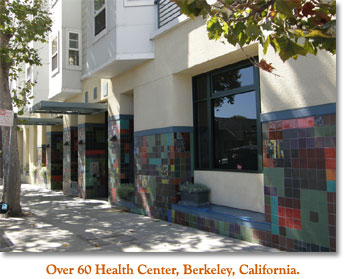
Over 60 ("Healthy") Tiles

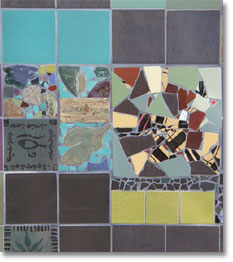
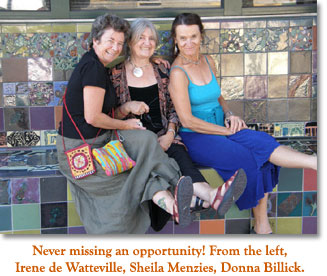
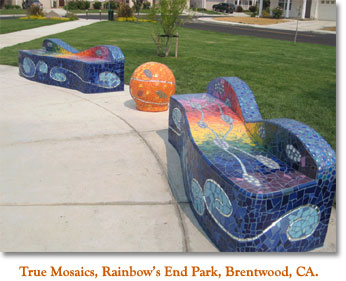
True Mosaics Brighten Brentwood
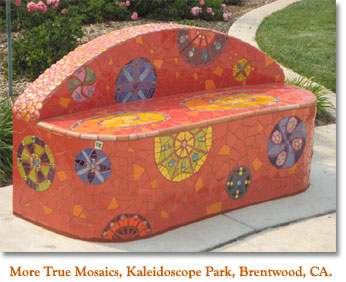
Where were you in '59, Pomona?

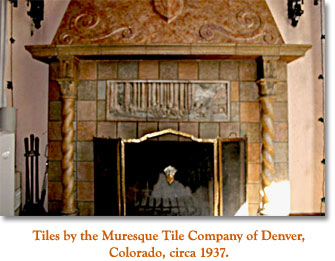
Just in from Denver!
New Books!

Tiling Complete
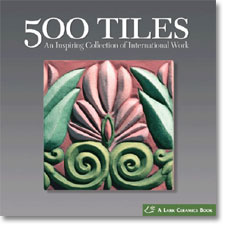
500 Tiles: An Inspiring Collection of International Work
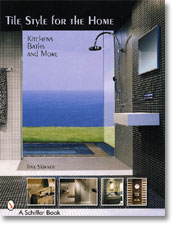
Tile Style for the Home: Kitchens, Baths, and More
